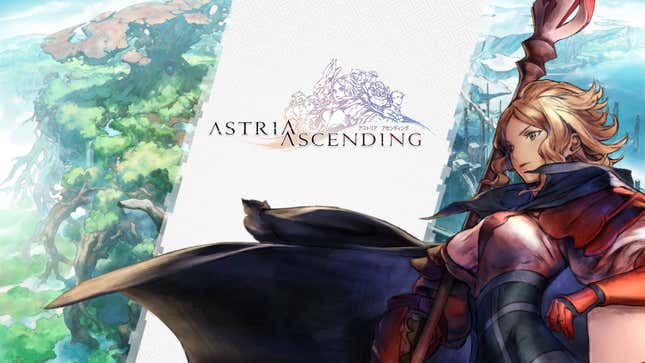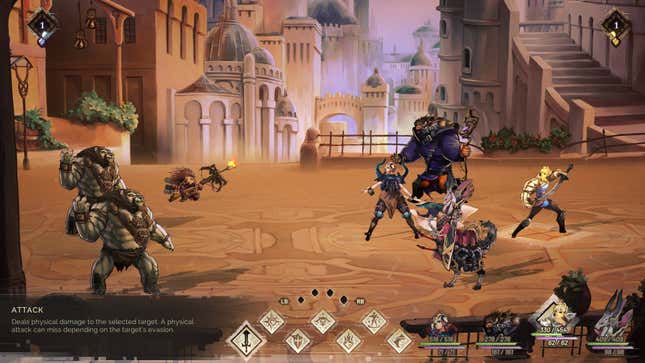
Astria Ascending is a turn-based JRPG with gameplay that pays homage to Bravely Default and Octopath Traveler. I enjoyed the combat in both of those titles, but the colorful art style of Astria Ascending felt like an upgrade from the somber color palette of those games. It also puts an interesting twist on the “plucky-adventurers-save-the-world” story formula, though I’m not entirely convinced that the execution lands.
Astria was made by French-Canadian developer Artisan Studios, but some of the developers behind the game are veterans from the Final Fantasy series, NieR:Automata, and Bravely Default. The game also includes Japanese and English voice-overs. So even though the game isn’t from Japan, it feels like a JRPG in terms of aesthetics. Astria promises a 50-hour campaign, eight robust characters, and a more mature narrative than other games in its genre.
The Final Fantasy influences carry over to the fantastical art style. Astria has some of the most distinct and eye-catching character designs I’ve seen in a western roleplaying game. All the backgrounds in its two-dimensional environments are lovingly hand-painted. Sometimes I would return to old locations to go sightseeing. And, somehow, I find a new fascinating detail in the background every single time. If you asked me to describe Astria’s art in one word, I would tell you that the game is a “storybook.”
And maybe that aesthetic style is meant to soften how its serious plot lands. The twist is revealed in the very beginning of the game: Astria’s heroes are dying. Literally. Upon obtaining special powers as one of the “demi-gods” of the continent, the hero will die in three short years. When the story begins, all of our heroes have only three months to live. And despite the jokes about their impending doom, not all of them are taking it well.

Most JRPG heroes can have their disagreements, but they ultimately have to remain civil to each other if they want to survive a perilous journey. This isn’t so in Astria Ascending. The party members are constantly at odds. Instead of camaraderie, the overall mood of the party is filled with impatience, jealousy, and prejudice. Whenever I started a cutscene, I braced myself for the heroes to start verbally attacking each other. Does solidarity matter when their star-crossed fates are unavoidable? From what I’ve seen of the first half, the demi-gods don’t think so. I’m hoping that they sort out their shit in the second half, but the adventure feels pretty excruciating in the meantime.
In Astria’s setting, world peace was achieved because each nation sent one of their people to become a doomed demi-god. They also use emotion-regulating fruits called the harmelon, which is supposed to maintain coexistence between the races. The central plot also asks the player whether or not co-existence between different groups of people is worth it if it comes at a high personal cost. It’s an interesting philosophical question, but it didn’t stick with me.
In practical terms, coexistence between different groups does require sacrifice, but it’s never a life-or-death consideration. Nobody has to take medication in order to stop being prejudiced against people who are different from them. Stories are powerful when they rhyme with real life. Astria is so fantastical about the concept of coexistence that it loses me on the relevance of its themes.
More importantly, the constant sniping and the fantasy racism was uncomfortable to experience in practice. Maybe the game has something poignant to say about racism in the second half, but that doesn’t diminish how much I dreaded advancing to the next cutscene.
For how embittered the characters are towards one another, the party-based combat feels very, very good. Astria Ascending takes after JRPGs such as Octopath Traveler and Bravely Default in that you can store turns to use later. Normally in a JRPG, the player has to consider their team composition very carefully as elemental weaknesses play a large part in battle outcomes. While these mechanics exist in Astria, it feels less punishing when I bring the “wrong” characters into a battle. The ability to store one character’s turns to pass on to another character helps alleviate some of the pressure that comes with coordinating an optimal party for different fights.
However, the battles also feel chaotic because the game doesn’t have a turn indicator. Although Astria has a speed mechanic present in many JRPGs, it was difficult for me to engage with when I can’t remember who needs that bump. The lack of turn transparency also makes it very difficult to plan ahead and coordinate my attacks.
Despite efficient quality of life features like being able to teleport around the map, the signposting in this game is pretty atrocious. I spent a significant amount of time trying to find the next major quest location. Sometimes the game feels nice enough to tell you where to go next, but not how to get there. I often replayed cutscenes to figure out how to advance the plot, and I wish I had a detailed quest log instead. It almost feels like Astria Ascending is intent on allowing you to get lost in its inspiring scenery. Which is nice, but I want to be given the choice to prioritize the main campaign.
The game has its indie charm and sincerity. It’s easy for me to forgive where the game missteps narratively and mechanically when Astria Ascending goes so hard on artistic detail and lore. Even the characters’ job classes are assigned to specific zodiac signs. While I don’t necessarily like all the characters as people, it’s an impressive feat that each of them feel so distinct. I’m also a lot more tolerant of feeling lost in Astria’s world when I feel compelled to admire the colorful brushstrokes along the way. Astria isn’t a perfect game, but I’m not even mad about it.
If you loved Octopath Traveler as much as I did, then Astria Ascending is an obvious pick for your games backlog.